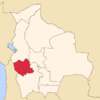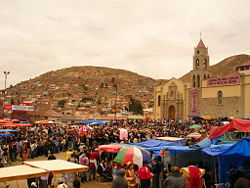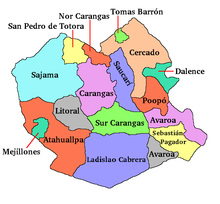- Oruro Department
-
Department of Oruro Santuario de la Virgen del Socavón, Carnaval de Oruro, 2007 
FlagLocation within Bolivia
Country  Bolivia
BoliviaCapital Oruro Provinces 16 Government – Governor Santos Tito (MAS-IPSP Area – Total 53,558 km2 (20,678.9 sq mi) Population (2005) – Total 384,494 – Density 7.18/km2 (18.6/sq mi) Time zone BOT (UTC-4) ISO 3166-2 BO-O Languages Spanish, Quechua, Aymara Website http://www.oruro.gob.bo/ Oruro is a department in Bolivia, with an area of 53,588 km². Its capital is the city of Oruro. At the time of census 2001 it had a population of 391,870.
Contents
Provinces of Oruro
The department is divided into 16 provinces which are further subdivided into municipalities and cantons.
Province Area (km²) Capital Atahuallpa 5,885 Sabaya Carangas 5,472 Corque Cercado 5,766 Oruro Eduardo Avaroa 4,015 Challapata Ladislao Cabrera 8,818 Salinas de Garcí Mendoza Litoral 2,894 Huachacalla Puerto de Mejillones 785 La Rivera Nor Carangas 870 Huayllamarca Pantaleón Dalence 1,210 Huanuni Poopó 3,061 Poopó Sajama 5,790 Curahuara de Carangas San Pedro de Totora 1,487 Totora Saucarí 1,671 Toledo Sebastian Pagador 1,972 Santiago de Huari Sud Carangas 3,536 Santiago de Andamarca Tomás Barrón 356 Eucaliptus Government
The chief executive office of Bolivia departments (since May 2010) is the governor; until then, the office was called the prefect, and until 2006 the prefect was appointed by the President of Bolivia. The current governor, Santos Tito of the Movement for Socialism – Political Instrument for the Sovereignty of the Peoples, was elected on 4 April 2010.
The chief legislative body of the department is the Departmental Legislative Assembly, a body also first elected on 4 April 2010. It consists of 33 members: 16 elected by each of the department's provinces; 16 elected based on proportional representation; and minority indigenous representative selected by the Uru-Chipaya people.
Gubernatorial Candidate Party Votes for Governor Percentage Assembly Members by Territory Votes for Assembly by Population Percentage Assembly Members by Population Total Assembly Members Santos Tito Movement for Socialism 107.576 59,6% 15 83.220 56,1% 10 25 Iver Pereira Vásquez Without Fear Movement 53.111 29,4 1 47.319 31,9% 5 6 National Unity Front 13.933 7,7% 0 12.277 8,3% 1 1 Guillermo Zolá Eugenio Nationalist Revolutionary Movement 5.800 3,2% 0 5.612 3,8% 0 0 Indigenous Representatives Elected through usos y costumbres 1 Valid votes 180.420 81,5% 148.428 67,1% Blank votes 28.055 12,7 62.222 30,2% Null votes 12.939 5,8% 10.706 4,8% Total votes 221.414 87,5% of registered voters 16 221.356 87,4% of registered voters 16 33 Source: Corte Nacional Electoral, Acto de Computo Nacional, Boletín 22: Explicación asignación de escaños departamentales Languages
The languages spoken in the department are mainly Spanish, Quechua and Aymara. The following table shows the number of those belonging to the recognized group of speakers.[1]
Language Department Bolivia Quechua 134,289 2,281,198 Aymara 127,086 1,525,321 Guaraní 383 62,575 Another native 1,943 49,432 Spanish 342,332 6,821,626 Foreign 6,878 250,754 Only native 30,745 960,491 Native and Spanish 188,963 2,739,407 Spanish and foreign 153,439 4,115,751 Notable people
- Evo Morales who has been the Bolivian president since 2006 was born in the little village of Isallawi near Orinoca.
Places of interest
- Sajama National Park
- Parinacota Volcano
- Sajama Lines
- Poopó Lake
- Lake Uru Uru
See also
References
- ^ obd.descentralizacion.gov.bo (Spanish)
External links
- Oruro Travel Guide
- Weather in Oruro
- Carnaval 2009 folklore
- Technical University of Oruro
- Oruro News
- Feria Exposición
 Chisholm, Hugh, ed (1911). "Oruro". Encyclopædia Britannica (11th ed.). Cambridge University Press.
Chisholm, Hugh, ed (1911). "Oruro". Encyclopædia Britannica (11th ed.). Cambridge University Press.
 Oruro DepartmentCapital: Oruro
Oruro DepartmentCapital: OruroProvinces 
Municipalities (and seats) Andamarca (Andamarca) • Antequera (Antequera) • Belén de Andamarca (Belén de Andamarca) • Caracollo (Caracollo) • Carangas (Carangas) • Challapata (Challapata) • Chipaya (Chipaya) • Choquecota (Choquecota) • Coipasa (Coipasa) • Corque (Corque) • Cruz de Machacamarca (Machacamarca) • Curahuara de Carangas (Curahuara de Carangas) • El Choro (El Choro) • Escara (Escara) • Esmeralda (Esmeralda) • Eucaliptus (Eucaliptus) Huachacalla (Huachacalla) • Huayllamarca (Huayllamarca) • La Rivera (La Rivera) • Machacamarca (Machacamarca) • Oruro (Oruro) • Pampa Aullagas (Pampa Aullagas) • Pazña (Pazña) • Sabaya (Sabaya) • Salinas de Garcí Mendoza (Salinas de Garcí Mendoza) • Santiago de Huari (Santiago de Huari) • Santuario de Quillacas (Santuario de Quillacas) • Todos Santos (Todos Santos) • Toledo (Toledo) • Totora (Totora) • Turco (Turco) • Huanuni (Huanuni) • Poopó (Poopó) • Yunguyo del Litoral (Yunguyo)Departments of Bolivia Beni · Chuquisaca · Cochabamba · La Paz · Oruro · Pando · Potosí · Santa Cruz · Tarija

Coordinates: 18°40′S 67°40′W / 18.667°S 67.667°W
Categories:- Oruro Department
- Departments of Bolivia
- Bolivia geography stubs
Wikimedia Foundation. 2010.


